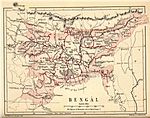Bhavashankari
| Bhavashankari | |
|---|---|
| Maharani of Bhurishrestha Raybhagini | |
| Coronation | 1570 |
| Predecessor | Rudranarayan |
| Successor | Mughal Empire (1616) |
| Spouse | Rudranarayan |
| Father | Dinanath Chaudhuri |
| Religion | Hinduism |
| History of Bengal |
|---|
 |
Maharani Bhavashankari (Maharanī Bhavaśaṅkarī) was a ruler of Bhurishreshtha kingdom of Bengal.[1] After her husband's death, she ruled the country as the Queen Regent. She was associated with Baro-Bhuyan. After her death, Mughal Empire ruled her dynasty.[2]
Early Life and Background
[edit]Bhavashankari, also known as Raibaghini, was a prominent queen of the Bhurishrestha Kingdom in Bengal during the 16th century. She was the wife of Maharaja Rudranarayan and played a crucial role in defending her kingdom against external invasions. Born into a noble family, she was trained in warfare, administration, and governance from an early age.[3]
Her father, a military commander of Bhurishrestha, ensured she received rigorous training in swordsmanship, archery, and horse riding. In addition to her martial prowess, Bhavashankari was well-versed in statecraft, politics, and religious philosophy. She was also a devotee of Goddess Chandi and built several temples dedicated to the deity.
Marriage and Rise to Power
[edit]Bhavashankari was married to Maharaja Rudranarayan, the ruler of Bhurishrestha. Her military skills and intelligence impressed the king, and she soon became an influential figure in the royal court. She actively participated in governance and military campaigns alongside her husband.[3]
Following Maharaja Rudranarayan’s untimely death, Bhavashankari assumed the responsibility of ruling the kingdom. The period following her husband’s demise was turbulent, as Bhurishrestha faced threats from both internal conspiracies and external invasions, particularly from the Pathan warlords and Afghan chieftains who sought to dominate Bengal.
Military Campaigns and Resistance Against Pathan Forces
[edit]One of Bhavashankari’s greatest achievements was her successful resistance against the resurgence of the Pathan forces in Bengal, led by the Lohani Sultans and their allies. She mobilized her army and led them personally in battles, demonstrating exceptional strategic acumen.
Her most notable military engagement was the Battle of Bashuri, where she defeated the Pathan invaders attempting to seize control of Bhurishrestha. She employed guerrilla warfare tactics, fortified key regions, and effectively utilized war elephants, cavalry, and archers in battle. Her leadership ensured the continued sovereignty of her kingdom against foreign aggressors.
Alliances with the Mughals
[edit]Bhavashankari’s valor and military success gained recognition from the Mughal Emperor Akbar. The Mughals, who were also engaged in suppressing Afghan rebellions in Bengal, saw her as a powerful ally. She was honored with the title “Raibaghini” (Royal Tigress) for her fierce resistance against the Pathans. Under her rule, Bhurishrestha maintained its autonomy while forging strategic alliances with the Mughal Empire.[3]
Legacy and Influence
[edit]Bhavashankari’s rule left an enduring impact on Bengal’s history. She became a symbol of resistance against foreign dominance and the preservation of Hindu sovereignty in the region. Her successful military campaigns and wise governance ensured Bhurishrestha remained a formidable power.[3]
Even today, she is revered as a legendary warrior queen, and her legacy continues to inspire generations. The Raibaghini Temple in Udaynarayanpur, Howrah, stands as a testament to her contributions and bravery.
Her life has been immortalized in folklore, regional literature, and recently in cinema, bringing renewed attention to her extraordinary story. Bhavashankari remains one of the greatest warrior queens of Bengal, remembered for her courage, leadership, and dedication to her people.
References
[edit]- ^ Deshpande, Y. K. (1945). "Raya Baghinis, the Brave Brahmin Ladies of India". Proceedings of the Indian History Congress. 8: 298–302. ISSN 2249-1937. JSTOR 45435434.
- ^ GANGULI, SAMIR (30 September 2023). THE ZAMINDARS AND NAWABS OF BENGAL. Blue Rose Publishers. p. 39.
- ^ a b c d "Who Is Rani Bhavashankari: মুঘলদের যম ভবশঙ্করীর ভূমিকায় শুভশ্রী, বাংলার এই বীরাঙ্গনা রানির আসল কাহিনী গায়ে কাঁটা দেবে | Subhashree Ganguly New Movie Raybaghini Bhavashankari | India Hood News |". 8 February 2025. Retrieved 8 February 2025.
Bibliography
[edit]- Bhattacharya, Bidhubhusan (2009). Raybaghini O Bhurishrestha Rajkahini. Kolkata: Nababharati Prakashani.
- Ray, Bharat Chandra. Raibaghini.
